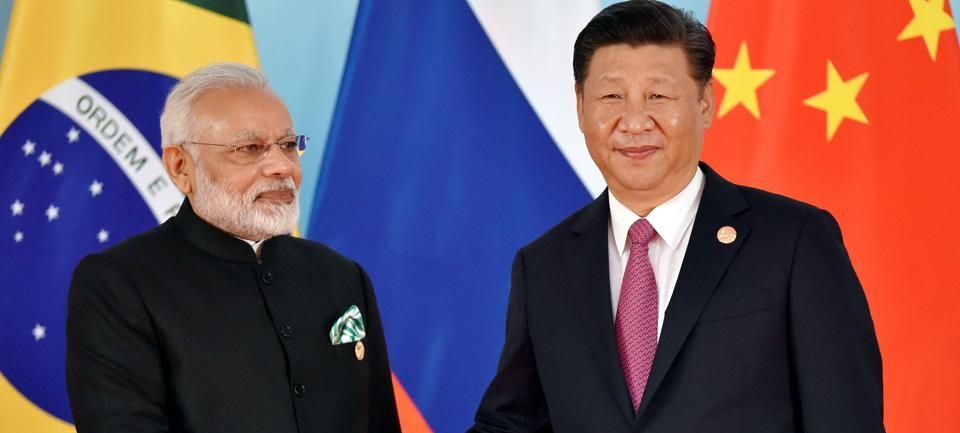India-China strategy
April 30, 2018 | Expert Insights

India and China have announced that the two nations would work harder to improve military communications. The announcement comes less than a year after a military stand-off took place between the two nations in Doklam.
Background
India’s contemporary relationship with China began in 1950. Between 1960 and 1987, India and China have been involved in three major military conflicts. A bilateral relationship has since been established, but both nations have often been pitted against one another as they are neighbours, and two of the fastest growing economies in the world. They have never completely resolved their border problems and Chinese troops have reportedly infringed upon Indian Territory over the years.
In June 2017, a skirmish broke out between Indian and Chinese troops at the Doklam plateau. The area is a disputed territory between Bhutan (an Indian ally) and China. For nearly three months both nations were engaged in a military stand-off. Another scuffle between Indian and Chinese troops broke out in August 2017. The two sides took to throwing stones at one another at Pangong Lake in Ladakh. 15 Chinese soldiers had reportedly crossed into Indian territory and did not turn back despite repeated warnings.
In 2017, China’s Senior Colonel Wu Qian of the PLA and Defence Ministry warned, “We remind India to draw lessons from the stand-off, abide by established treaties and the basic principles of international law, and work together with China to safeguard peace and stability along the border and promote the healthy development of the two militaries.”
Analysis
In February 2018, the Chinese state media published a report noting that the country would be upgrading its Western Theater Command, in order to confront any threat from India. At the time, Kanti Prasad Bajpai, the director of the Centre on Asia and Globalization at Singapore's Lee Kuan Yew School of Public Policy said, “It's fairly clear they (the Chinese) are trying to send a message in the post-Doklam period about their resolve to be strong.”
In a bid to avoid another military stand-off, China and India have pledged to improve military communication between the two countries. Indian Prime Minister Narendra Modi and Chinese leader Xi Jinping held free ranging talks aimed at improving strained ties between the two countries.
“The China-India relationship should be a stable and developing one, with mutual trust as the foundation,” Xi was quoted as saying by Xinhua. “In the next step, the two countries should make a comprehensive plan for cooperation and further enhance strategic communication [to enable] timely negotiation on major issues.”
An Indian official was quoted as noting, “There will be some cooling down of operational tensions, which spiked during the Doklam crisis near the Sikkim-Bhutan-Tibet trijunction last year and have carried on till now. There are enough mechanisms in place, from banner drills, flag meetings and border personnel meetings (BPMs) to the WMCC (working mechanism for consultation and coordination) and diplomatic channels, to manage and defuse faceoffs.”
According to estimates, India recorded 426 "transgressions" by the PLA across the LAC (the number was 273 in 2016), with as many as 218 faceoffs. The leaders have also agreed to “properly handle and manage disputes” and to “fair settlement” of their border disputes, Xinhua reported.
China’s efforts to improve ties with India, comes during a particularly difficult time for the nation. Reports have emerged that it may be left out in the upcoming summit between US and North Korea. Thus, the country may not have direct involvement in what happens in the Korean peninsula. It is possible that perhaps this uncertainty has prompted China to strengthen ties with India in order to diffuse any further threats to its sovereignty. This could also be the reason, why China has eased pressure on India to join the One Belt One Road initiative.
Improved ties between India and China could however cause concern for another of India’s neighbors – Pakistan. “I’m sure there’s a bit of unease among the Pakistani military brass about this summit and the apparent detente. Still, the military won’t be overly concerned, as it will conclude – rightly so, in my view – that China very much remains in Pakistan’s orbit, regardless of this new India-China warming period that could well prove short-lived,” said Michael Kugelman, deputy director of the Asia programme at The Wilson Centre, a Washington think tank.
Assessment
Our assessment is that the crisis in Doklam proved that the current systems in place between India and China do not effectively address problems arising at the Line of Actual Control. We believe China has taken the initiative to thaw ties with India as it faces resistance from the international community over its ambitious OBOR project. In addition, the country may be fearing the loss of its own influence as it may be left out of peace talks regarding the Korean peninsula. As far as India is concerned, the government will try and avoid another military stand-off with China and perhaps ensure its borders remain secure.








Comments